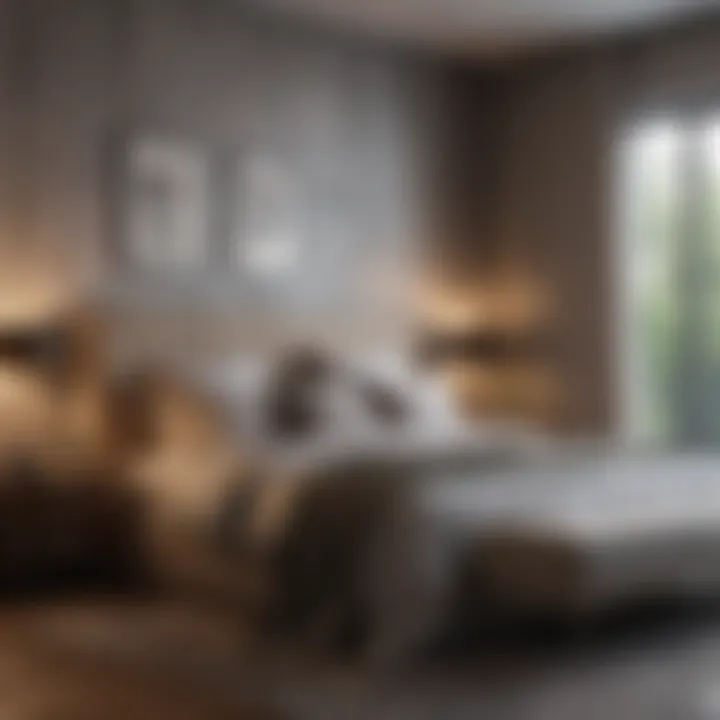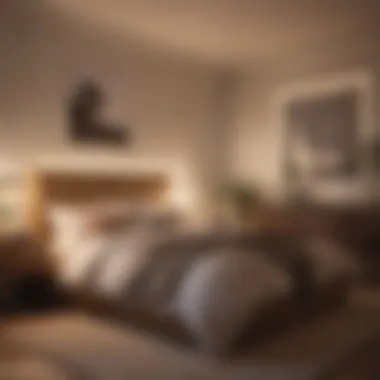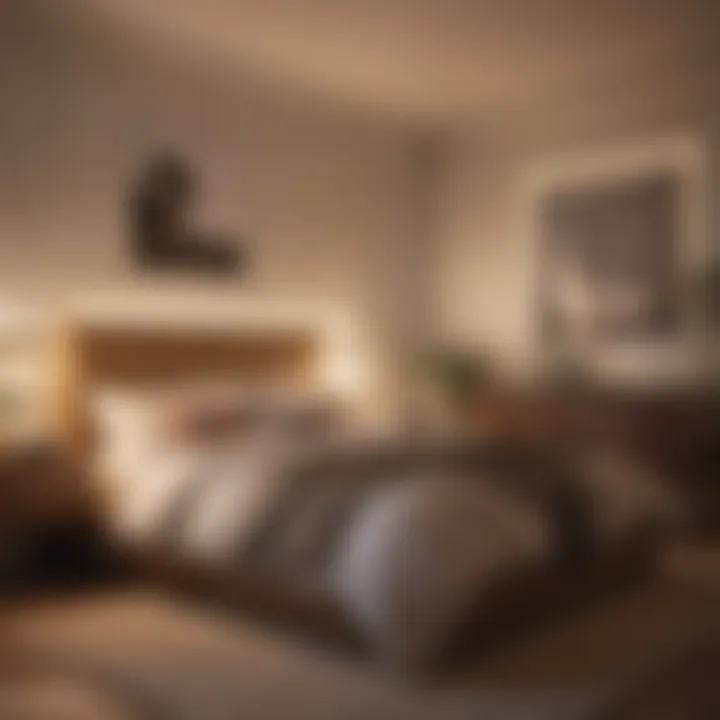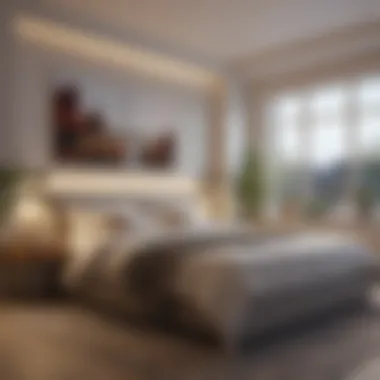Stylish Bedroom Design: A Comprehensive Guide


Intro
Creating a stylish bedroom is not just about throwing in a few trendy accessories or splashing a fresh coat of paint on the walls. It's an art that demands attention to detail and a good grasp of what makes a space truly inviting and functional. From selecting the right color palette to arranging furniture in a way that promotes relaxation and coziness, each decision contributes to the overall ambiance of your bedroom. This comprehensive guide aims to navigate through the essential elements of stylish bedroom design, arming you with insights that help transform your space into a personal haven.
Interior Design Tips
Designing the perfect bedroom requires more than just an eye for aesthetics. Here are some interior design tips that can uplift your space without giving you a headache:
- Personal Expression: Your bedroom is your sanctuary. Infuse it with elements that reflect your personality, whether it’s a favorite artwork, travel memorabilia, or an heirloom piece of furniture.
- Comfort Over Trends: Trends will come and go, but comfort must be a priority. Choose furnishings that not only look good but feel good as well.
- Layering Textures: Textures play a vital role in creating a cozy atmosphere. Think about layering different fabrics—soft linens, plush throw pillows, and chunky knitted blankets.
"Your bedroom should make you feel good, not just look good." - Unknown
Trendy Design Ideas
While it's essential to maintain your unique style, keeping an eye on current trends can help you stay refreshed. Here are a few ideas that can be easily incorporated:
- Bohemian Vibes: Use a mix of bold patterns, natural materials, and handcrafted items to create a laid-back bohemian look.
- Minimalist Aesthetics: Adopt a less is more approach with clean lines and simple forms. High-quality, functional pieces can speak volumes in a minimalist setting.
- Vintage Touches: Vintage items can add character. Look for mid-century furniture or antique decor that tell a story.
Color Schemes and Combinations
Colors set the mood, so it’s crucial to choose wisely. Here are successful combinations:
- Serene Neutrals: Soft beiges and whites can create a calm environment, allowing for a restful sleep.
- Earthy Tones: Greens, browns, and muted yellows can open up space and bring in an organic, grounding vibe.
- Bold Accents: Consider a deep navy or emerald green as an accent wall, paired with lighter furniture for contrast.
Experiment with swatches to see how colors interact with light and other surrounding elements.
Furniture Arrangement Techniques
The layout of your bedroom can greatly affect its functionality. Here are tips to keep in mind:
- Focus on the Bed: Centered against a wall, the bed should be the focal point. Ensure that there's ample space on either side for bedside tables.
- Flow: Arrange furniture to allow a smooth travel path. Avoid cluttering corners or doorways, so it feels open and inviting.
- Multi-functional Pieces: In smaller rooms, consider furniture that serves multiple purposes, like a bed with storage or a desk that doubles as a nightstand.
In essence, smart bedroom design capitalizes on personal style while balancing beauty with functionality. With these tips in your arsenal, you can create a bedchamber that not only looks good but feels like home.
Understanding the Essence of Bedroom Design
When it comes to designing a home, the bedroom often takes a backseat in conversations about aesthetics and functionality. Yet, understanding its essence is essential for creating a tranquil and inspiring living space. A bedroom is not just a place to sleep; it serves as a personal sanctuary, a retreat from the chaotic world outside. It reflects one’s personality and offers comfort and style—a space where individuals unwind and recharge.
For homeowners and those keen on interior design, grasping the fundamental elements that make a bedroom both stylish and functional can make a world of difference. It’s worth pondering how various factors like layout, color, and lighting contribute to the overall experience. Balancing these elements harmoniously can transform a simple room into an inviting haven.
Furthermore, a well-designed bedroom can enhance one’s quality of life. It plays a pivotal role in how we relax, the rest we get, and even our productivity levels during the day. A cozy, well-lit bedroom not only facilitates restful sleep but also creates an atmosphere that encourages relaxation and peace.
The Role of a Bedroom in Home Architecture
In everyday life, many overlook the strategic importance of the bedroom in home architecture. From a design perspective, the bedroom influences the flow and functionality of a home. Its placement in relation to other rooms can affect privacy, visibility, and even the perceived spaciousness of a dwelling. Picture a situation where the master suite is tucked away in a private corner of the house. It provides a peaceful retreat, away from the hustle and bustle of family life and guests passing through the living areas.
Beyond practical considerations, the architectural style of a bedroom can resonate with the overall theme of the home. Whether it’s modern minimalism or traditional charm, the bedroom should echo the architectural narrative. This synergy enriches the aesthetic appeal and promotes a unified design throughout the space.
Historical Perspectives on Bedroom Designs
To truly appreciate the evolution of bedroom design, it’s pertinent to glance back at history. The early days saw bedrooms as mere functional spaces, often adorned with minimal furnishings. A typical medieval bedroom would consist of a bed, perhaps a chest for storage, and not much else. However, as time marched on, these private spaces underwent transformation, reflecting societal changes, cultural influences, and technological advancements.
The Victorian era brought with it an opulent approach to bedroom design. Rich fabrics, bold colors, and intricate furniture defined the aesthetics of the time. Fast forward to the 20th century, and we see minimalism entering the scene, prioritizing simplicity and functionality over decoration.
Today, the bedroom design landscape is incredibly diverse, with influences drawn from various styles and periods. Contemporary trends tend to emphasize comfort and personalization, making it crucial to curate a space that not only looks good but feels good. Through the ages, trends have come and gone, but the essence of a bedroom remains constant: a space for rest, reflection, and rejuvenation.
"The bedroom is a personal narrative, a unique space that can both comfort and inspire. It represents our inner selves, all wrapped up in texture, light, and design."
In summary, understanding the critical role of the bedroom within the architectural fabric of a home and its historical evolution opens avenues for informed design choices. By appreciating these elements, one can create a bedroom environment that truly resonates with their lifestyle and preferences.
Core Principles of Stylish Design
Crafting a stylish bedroom goes beyond just placing furniture or throwing on a fresh coat of paint. It's about creating an environment that echoes comfort and functionality while incorporating aesthetic appeal. The core principles of stylish design serve as the backbone of any bedroom, ensuring that each element harmonizes with the others to provide not only a restful retreat but also a space that feels uniquely yours.
Understanding these principles helps in making choices that resonate with personal taste and functional needs, whether one desires a serene sanctuary or a buzzing hub of creativity. Just as an artist combines hues on a palette, thoughtful designers blend various elements to create a beautiful composition. This section delves into two vital concepts: harmony and balance in interior spaces, along with the ever-important dimensions of proportion and scale.
Harmony and Balance in Interior Spaces
One of the cornerstones of stylish design is harmony and balance. Much like a symphony, where different instruments come together to create a beautiful sound, a well-designed bedroom requires all elements to work together cohesively. Achieving balance means ensuring that the visual weight of the furniture, colors, and textures are distributed evenly throughout the space. Without it, the room may feel cluttered or chaotic, disrupting the calm that a bedroom should offer.
- Colors and Patterns: Selecting a harmonious color palette is essential. Too many competing colors can lead to visual noise, making the space feel hectic. Instead, choose a primary color and layer with complementary hues to create a soothing flow.
- Furniture Arrangement: Be mindful while placing your bed, dressers, and other furniture. As a rule of thumb, try to avoid pushing everything against the wall, which can often lead to a stiff, uninviting look. Allow pathways and balance in arrangements to foster a sense of openness.
- Textural Contrasts: Mixing textures can enrich a bedroom's appeal, but moderation is key. Soft linens paired with a plush rug and perhaps a rough wooden bench can work well together if introduced thoughtfully.
A harmonious bedroom offers not just a feast for the eyes but also a tranquil retreat. It’s a reminder that design should not only look good but also feel good.
Proportions and Scale Considerations
Following the harmony of elements comes the idea of proportions and scale in design. Every piece of furniture, art, or decor has a specific size that dictates how it fits within the broader scheme of the room. Choosing appropriately scaled items is crucial; introducing oversized furniture in a small bedroom can create an oppressive feeling, akin to wearing too-small shoes.
When assessing scale, consider:
- Room Size: A large, sprawling bed may look stunning in a spacious room but may feel cramped in tighter quarters. Opting for a platform bed or a bed with built-in storage can help maintain visual balance.
- Ceilings and Height: High ceilings open a wealth of possibilities — consider tall, elegant lamps or artwork that draws the eye upward. Conversely, in a low-ceiling room, it’s best to keep decorative elements closer to the ground, which can create a more intimate atmosphere.
- The Functionality of Space: Reflect on how you plan to use the bedroom. If it’s a place for rest, the design should promote comfort rather than overcrowding with unnecessary decor. Keep an eye on functionality while maintaining those elegant proportions.
"Small changes in proportions can make a big difference in how a space feels and flows."
Ultimately, embodying these principles ensures that a bedroom evolves into a stylish cocoon that stands the test of time. It creates a balanced space where harmony and function meet, resulting in an inviting retreat tailored to your individual lifestyle and aesthetic preferences.
Color Schemes That Transform
Choosing a color scheme for a bedroom isn’t just a matter of aesthetics; it plays a pivotal role in how the space feels and functions. The right colors can turn a simple room into a serene sanctuary or an energizing retreat. Delving into this aspect of design is vital, as it ties closely with not only our emotional well-being but also the physical environment in which we rest and recharge.
Color influences mood and atmosphere, so it's essential to approach it with intention. Whether it’s a calming palette that promotes tranquility or vibrant hues that evoke creativity, understanding the psychological impact of color can lead to an enriched bedroom experience.


Impact of Color Psychology on Sleep and Mood
When one considers the concept of color psychology, it becomes apparent that each hue carries its own set of associations, evoking specific feelings and reactions. For example:
- Blue: Often linked to calmness, blue can lower heart rates and improve sleep quality.
- Yellow: Bright and cheerful, it can stir creativity and stimulate energy, but too much might lead to overstimulation.
- Green: Symbolizing nature, it has a balancing effect that can instill a sense of peace.
In designing a bedroom, soft and muted tones can create a relaxing atmosphere conducive to sleep. Consider using light shades of lavender or pale grey on the walls to promote relaxation. Some studies suggest that individuals who sleep in blue rooms average deeper sleep compared to those in rooms painted with vibrant colors.
Furthermore, beyond just colors on walls, accents can shape the ambiance as well. For instance, incorporating earth tones with textiles can unify the space and lead to a more restful environment. Remember, creating a space that feels inviting and tailored to your mood can significantly shift your nighttime experience.
"Color is the keyboard, the eyes are the harmonies, the soul is the piano with many strings."
— Wassily Kandinsky
Current Trends in Color Palettes
In recent years, bedroom color palettes have evolved, reflecting broader lifestyle shifts and design preferences. Some of the most popular trends currently transforming bedroom designs include:
- Earthy Tones: Shades like terracotta, taupe, and muted olive remain popular, offering a grounded, organic feel.
- Muted Pastels: Soft pinks, blues, and greens are making waves, providing a delicate and serene backdrop without overwhelming the senses.
- Monochromatic Schemes: This involves varying shades of a single color, allowing for a sophisticated yet straightforward look.
- Neutrals with Bold Accents: Although neutrals like beige or soft white are timeless, pairing them with vibrant colors for accessories creates visual interest while maintaining a balanced atmosphere.
As trends change, individuals are more inclined to experiment with color in new ways, stepping outside their comfort zones. Incorporating seasonal colors, such as warm tones in the fall and cool hues in the summer, can also keep the space feeling fresh.
Ultimately, the key is to find a palette that resonates personally. Remember, the colors you choose profoundly shape the energy of the room, ultimately affecting your comfort and satisfaction with the space.
Furniture Selection and Layout
When it comes to stylish bedroom design, the selection and arrangement of furniture play a pivotal role. It’s not just about filling the space; it’s about creating an environment that promotes relaxation and comfort. The furniture must reflect both functionality and aesthetics. Carefully choosing each piece and knowing how to place it can transform a standard bedroom into a personalized sanctuary.
Essential Furniture Pieces: Bed, Nightstands, and Storage
The foundation of any well-designed bedroom is undoubtedly the bed. It’s where we spend a considerable portion of our lives, after all. Thus, picking a bed that embodies comfort and style is paramount. A solid frame, perhaps a plush headboard, can set the tone. Likewise, there are choices like a king versus a queen size or a platform bed versus a frame with a box spring, each offering different aesthetics and functionalities.
But a bed isn’t complete without nightstands. These pieces serve not only as practical spots to place a lamp or a book but also contribute to the overall softening of the space. Ensure the nightstands complement the bed in style and height to maintain harmony.
Storage options are equally essential. Not every bedroom has the luxury of a walk-in closet, so creative storage solutions can be lifesavers. Consider utilizing under-bed storage boxes or vertical shelving units. A stylish dresser can add both flair and function, providing a space to tuck away clothes while also adding to the design.
"Choosing the right furniture is akin to selecting the ingredients for a fine meal. Each piece should harmonize with others to create a delightful composition."
Optimizing Space with Layout Strategies
In any room, the layout and flow can make all the difference. A bedroom should feel inviting, spacious, and not cramped. To optimize space, start by visualizing the natural movement within the room. Think about how you use the space daily: Do you need easy access to your wardrobe? Should the path from the bed to the door be unobstructed?
Here are some strategies for effective layout:
- Zoning the Room: Create different areas within the space, like a reading nook or a workspace. This can help to utilize every corner without feeling cluttered.
- Focusing on Focal Points: A bed may serve as the room's centerpiece, but artwork or a statement wall can also draw attention. Place furniture to enhance this focal point.
- Keeping Walkways Clear: Ensure there's enough space for people to move about comfortably. A general rule is to keep a two to three-foot clearance around larger pieces.
Choosing the right arrangement based on factors like furniture size, room shape, and personal lifestyle preferences results in a bedroom that feels both balanced and functional. A well-considered layout not only elevates the bedroom’s style but also enhances daily living, making each day start and end on a positive note.
In summary, balancing quality furniture selection with intentional layout strategies can yield not just a beautiful bedroom, but also a space that reflects the lifestyles and desires of those who inhabit it.
Textiles and Soft Furnishings
In the art of bedroom design, textiles and soft furnishings play a vital role, akin to the finishing touches in a painting. They are not merely decorative; they significantly influence comfort and ambiance. The careful selection of materials affects how the space feels and looks—each fabric choice conveys a sense of personality and warmth.
Choosing the Right Bedding
When it comes to bedding, the choices are practically endless. A bed adorned with luxury linens can feel like a five-star hotel retreat every night. Here are some points to consider:
- Fabric Types: Opt for natural fibers like cotton or linen, renowned for breathability. These materials help regulate temperature, making your slumber experience much more comfortable.
- Thread Count: It’s easy to think higher thread count equals better quality, but it’s not the only factor. Sometimes, 400-thread cotton feels softer than 600-thread polyester blends.
- Color and Patterns: The bedding's color scheme should harmonize with your overall bedroom palette. Soft, muted colors promote relaxation, while bold patterns can energize the space. Consider using duvet covers that can be easily changed to reflect seasonal shifts.
Choosing bedding that feels good against your skin while complementing the overall decor ensures a cozy retreat.
Layering Textures for Comfort and Aesthetics
Just like a casserole, layering textures adds depth and interest to a bedroom's appearance. The idea is to mix materials to enhance both visual appeal and tactile comfort. Here’s how to master the art of layering:
- Mix Fabrics: Consider combining silk, velvet, and chunky knits. Each material brings its own character. For example, thick knits contrast well against smooth surfaces while providing warmth in touch.
- Throws and Pillows: Decorative pillows are no longer just for aesthetics; they bring the comfort factor into play. Use varying sizes, from large lumbar to small squares, and combine colors and patterns that add zing. Throws can be artfully draped across the bed or a chair, inviting relaxation.
- Rugs: An area rug adds another layer of texture and can visually define areas within your bedroom. Choose a plush rug for warmth underfoot, especially during colder months.
“Textures are the visual spices of design; they can transform your space from bland to grand.”
Adding different textures creates a multi-dimensional feel in your bedroom, making it a cozy escape. Whether it’s the warmth of a wool blanket or a silky pillow, each fabric contributes to an inviting atmosphere.
By paying attention to these elements, you can craft a bedroom that is not only stylish but also a haven of comfort.
Lighting: Setting the Mood
In the realm of bedroom design, lighting plays a pivotal role in crafting the ambience and mood of the space. It’s not just about illumination; it’s about evoking feelings, setting tones, and enhancing the overall aesthetic. The right lighting can transform a simple bedroom into a cozy retreat where one can unwind after a long day. Effective lighting design does more than brighten a room—it influences how the space is perceived and felt.
When considering lighting, it's essential to think beyond just the fixtures themselves. Light behaves differently depending on its source, color temperature, and placement within the room. Soft, warm lighting may create a comforting environment ideal for relaxation, while bright white lights might be better suited for tasks like reading or getting dressed. Thus, successful bedroom lighting encompasses functionality and aesthetic appeal, carefully marrying these two elements for an inviting atmosphere.
"Lighting is like makeup for your home; it can either enhance or detract from the beauty of your space."
Types of Lighting: Ambient, Task, and Accent
To effectively set the mood in a bedroom, three primary types of lighting should be incorporated: ambient, task, and accent. Each serves a unique purpose and can complement one another to create layered lighting, which adds depth and dimension to the room.
- Ambient Lighting: This is the foundational layer of light in a bedroom, providing overall illumination. Examples include ceiling-mounted fixtures, chandeliers, or floor lamps. The goal is to ensure the space is comfortably lit for general navigation and activities without creating harsh glare.
- Task Lighting: This type is aimed at particular activities, such as reading, writing, or any task that requires focused light. Desk lamps, bedside table lamps, or wall-mounted reading lights fall into this category. Task lighting should be bright enough to assist in specific tasks while maintaining a soft ambiance around it.
- Accent Lighting: Used to highlight architectural features, artwork, or furniture pieces, accent lighting adds character to the room. Sconces, LED strip lighting behind furniture, or picture lights can draw attention to specific areas, creating visual interest and warmth.
Combining these types allows for a more versatile space where one can easily shift from winding down at night to reading or engaging in hobbies without feeling confined to a single style of lighting.
Smart Lighting Solutions in Modern Design
In today’s rapidly advancing world, technology plays an increasingly significant role in bedroom design, and lighting is no exception. Smart lighting solutions offer homeowners a way to fully harness this technology for enhancement of both convenience and atmosphere.


Smart bulbs and fixtures can be controlled remotely via smartphones or voice-activated devices. This technology allows users to adjust their lighting with a simple command or tap, tailoring brightness and color to fit the moment, whether it’s a bright morning wake-up or a dimmed, serene evening. Some noteworthy considerations include:
- Adjustable Color Temperatures: With smart bulbs, you can choose between warmer hues to create a cozy feeling or cooler tones for energy and alertness.
- Scheduling: Set lights to gradually brighten in the morning, mimicking a natural sunrise, and dim in the evening for a calming wind-down.
- Integration with Home Automation Systems: Many smart lighting solutions integrate seamlessly with wider smart home systems to sync with alarms, entertainment systems, or security lights.
- Energy Efficiency: Smart lights often consume less power, benefiting both the environment and your wallet.
The incorporation of technology into bedroom lighting opens up a world of possibilities. Homeowners can curate their environments to match their moods or needs, making every day feel a touch more special.
With the right lighting, your bedroom can serve not just as a place to sleep but as a sanctuary that reflects personal creativity and comfort.
Incorporating Personal Style
Bringing personal style into a bedroom is not just about aesthetics; it's about creating a space that resonates with who you are. This section emphasizes the significance of infusing individual personality into design choices, helping to cultivate a warm, welcoming haven. Much like a painter layering colors on a canvas, you can craft a unique bedroom design using specific elements that reflect your personality and life experiences.
Utilizing Art and Decorations
Art and decorations are the heartbeat of a stylish bedroom. They create focal points, evoke emotions, and tell a story. Consider, for instance, a collection of vintage photographs that can invoke a sense of nostalgia. Or maybe handcrafted pottery that echoes travel memories. The key is to select pieces that resonate with you, making the space feel alive.
- Choose Art Wisely: Opt for artworks that spark joy or provoke thought. Maybe an abstract piece that catches the eye or a landscape that reminds you of a cherished place.
- Decorative Elements: Think about layering in unique decorative items. These could include decorative vases, intricate wall hangings, or even travel souvenirs that have a story behind them.
- Personal Touches: Integrate meaningful objects, such as your favorite books on a shelf or family heirlooms displayed lovingly. These items can enhance your connection with the space.
Whether it's a colorful painting or a well-arranged bookshelf, every addition to your bedroom can become a statement of who you are.
Creating a Reflection of Individual Taste
To truly make a bedroom your own, it's essential that the decor reflects your taste and style. This isn't about following the latest trends; it's about curating an environment that feels authentic to you.
- Color Choices: Colors have a profound impact on moods. If you lean towards calmness, consider soothing blues and greens. Energetic personalities might prefer bold reds or yellows. Pick colors that not only catch your eye but affect how you feel within the space.
- Furniture Selection: Your choice of furniture can illustrate your personality traits. A sleek, modern desk might indicate professionalism, while a vintage rocking chair could suggest a love for nostalgia. It’s all about ensuring that each item complements you rather than just filling the room.
- Personalized Layout: Don’t feel constrained by conventional layouts. Experiment with arrangements until you find one that feels right. Maybe you prefer a snug reading nook, or perhaps a workspace that instills productivity.
When individuals step into your bedroom, they should feel a connection to you, as if your style leaps from the walls and decor. It's all about weaving your essence into the fabric of the space.
Sustainability in Bedroom Design
Creating a stylish bedroom goes beyond aesthetics. It involves conscious choices that can positively influence our planet. In today’s world, sustainability is not just a trend; it's a responsibility. As homeowners, we are in a unique position to make design choices that not only reflect our personal style but also contribute to the health of our environment. When we talk about sustainability in bedroom design, we consider various elements that ensure our living spaces are eco-friendly while being functional and visually appealing.
Eco-Friendly Materials and Practices
One of the first steps towards a sustainable bedroom is the use of eco-friendly materials. This encompasses everything from furniture to textiles.
- Furniture Woods: Opt for sustainably sourced woods, such as bamboo or reclaimed timber. These resources grow back quickly or are salvaged from old structures, reducing the need for new timber.
- Natural Fabrics: Choose bedding made from organic cotton, linen, or hemp. Unlike synthetic materials, these fabrics are biodegradable and free from harmful chemicals.
- Low-VOC Paints: When it comes to painting, select low or zero volatile organic compound paints. This will help improve indoor air quality while minimizing harmful emissions.
By choosing these materials, not only do we beautify our spaces, but we also support responsible manufacturing practices. It's about nurturing our environment, one design choice at a time.
Reducing Environmental Impact Through Design Choices
Sustainability isn't just about materials; it's also about how we design our spaces. Here are some strategic ways to make a difference through our bedroom layouts:
- Maximize Natural Light: Positioning furniture to harness natural light reduces the need for artificial lighting. Consider larger windows or skylights to fill your room with daylight, creating a mood-boosting environment.
- Energy-Efficient Appliances: If your bedroom includes items like a mini-fridge or charging stations, look for energy-efficient models. These can significantly cut energy consumption, benefitting both your wallet and the environment.
- Choose Timeless Design: Aim for classic styles rather than fleeting trends. By investing in timeless furniture and decor, you avoid the constant cycle of replacing items, effectively reducing waste.
"Sustainable design is not merely a choice, but a necessary evolution in how we interact with our homes and the planet."
In sum, integrating sustainability into bedroom design is not only beneficial for the environment but also enhances the overall quality of living. As you ponder your next bedroom refresh, think about how small changes can lead to significant impacts.
Maximizing Space and Functionality
When it comes to stylish bedroom design, an often overlooked but vital component is maximizing space and functionality. A well-considered bedroom doesn’t merely look good but serves its purpose efficiently. The interaction between design, layout, and function can make a significant impact on how one feels within the space. Homeowners and design enthusiasts alike must grapple with often cramped quarters where every inch counts.
Strategizing space use involves understanding personal needs and acknowledging the limitations of a room. Aligning design choices with practical constraints creates rooms that are not just aesthetic marvels but also offer utility.
Storage Solutions in Compact Bedrooms
In smaller bedrooms, storage solutions are a game changer. Implementing clever organizational methods can lead to a remarkable transformation. Instead of relying solely on traditional closets and drawers, think outside the box—quite literally.
- Beneath the bed: This often-neglected space is perfect for underbed storage boxes or drawers. Opt for slim, stylish containers that slide easily under the bed without creating clutter.
- Vertical shelving: Making the most of wall space is a fantastic way to gain additional storage. Floating shelves or wall-mounted units help to keep items off the ground while adding a decorative touch.
- Multi-purpose furniture: Consider furnishings that double as storage. For instance, a bench with built-in compartments at the foot of the bed provides a sleek look while hiding away linens or seasonal wear.
Leveraging these solutions results in a tidy environment that can make a compact room feel much larger than it actually is. Not only does it maintain style, but it enhances usability.
Multi-Functional Furniture for Small Spaces
When dealing with limited real estate, multi-functional furniture is essential. This approach to furniture design maximizes the utility of each piece while keeping the room sleek and open.
- Convertible beds: Murphy beds are iconic examples of bending the rules of bedroom design. When not in use, they disappear seamlessly into the wall, freeing up space for more activities or just a clearer path.
- Ottomans and poufs: Look for ottomans that provide both seating and storage. They can work as additional seating during gatherings or offer a place to stow away books, blankets, or other items.
- Desk that doubles as a vanity: In smaller spaces, a desk can serve multiple purposes. A well-positioned desk can be used for work during the day and transform into a vanity at night, with the addition of a mirror and handy storage.
Embracing multi-functional furniture not only saves space but enhances the versatility of the room, making it adaptable to the owner's changing needs.
"Design is not just what it looks like and feels like. Design is how it works." — Steve Jobs
In summary, maximizing space and functionality in bedroom design goes beyond aesthetics; it’s about creating an environment that is both beautiful and practical. Utilizing storage solutions and investing in multi-functional furniture empowers homeowners to design bedrooms that meet their unique needs while still reflecting personal style. By making thoughtful choices, you can cultivate a space that is not just visually appealing but truly functional.
Technology in Modern Bedroom Design
The advancements in technology have significantly influenced the way we think about bedroom design. This section delves into how modern technology enhances comfort and convenience in our personal spaces. With rising expectations of how we utilize our living areas, integrating technology is not merely an aesthetic choice—it's becoming essential. From smart home features to the visionary technologies shaping our bedrooms' futures, understanding these elements allows homeowners to create stylish, highly functional sleeping environments.
Integrating Smart Home Features
Smart home technology has made a lasting impact on bedroom dynamics, making our daily routines more efficient. These features offer an array of benefits:
- Convenience: Imagine controlling your bed, lights, and temperature from your smartphone or tablet. Smart devices allow you to adjust everything without getting up.
- Energy efficiency: Smart thermostats and lighting can significantly reduce energy use. These devices learn your habits and optimize the systems to save money on energy bills, contributing to a sustainable living environment.
- Personalized atmospheres: With smart controls, you can customize the ambience to suit your mood—soft lighting for a cozy evening reading or bright illumination when it is time to wake up.
Some popular products include Philips Hue smart bulbs for customizable lighting, Nest Thermostats for energy savings, and Amazon Echo for voice commands. It is essential, however, to choose systems that seamlessly integrate with each other.
Moreover, consider the layout to hide any clutter related to these devices. Your tech gadgets should complement the style of the room rather than distract from it.
The Future of Bedroom Design and Technology


The trajectory of bedroom design and technology is poised for dramatic shifts as we march toward a more interconnected future. There are several trends emerging that indicate where the space is headed:
- Artificial Intelligence (AI): As AI continues to grow, we could see beds that adjust to our sleep patterns, offering tailored support based on real-time feedback from wearables. Picture waking up rejuvenated because your mattress optimally adapted to your body's needs overnight.
- Augmented Reality (AR): The way we visualize design concepts will change through AR applications. Homeowners may soon be able to visualize potential décor in real-time without spending money on samples.
- Sustainability: With growing environmental awareness, future technologies will likely continue to emphasize eco-friendliness. Imagine beds made from biodegradable components or paints that actively purify the air.
"As we integrate modern technology, the essence of our bedroom transformations will not just embrace aesthetics but also enhance our quality of life."
Ultimately, the blend of functionality and style through technology in bedroom design represents a new realm of possibilities. It is about making intentional choices that enhance the living experience, considering both personal preferences and sustainable practices. By thoughtfully incorporating tech, homeowners can create bedrooms that resonate with contemporary values while remaining stylish and inviting.
Seasonal Decor Considerations
In the realm of interior design, the changing seasons present an excellent opportunity to refresh and rejuvenate your bedroom. Seasonal decor considerations not only enhance aesthetic appeal but also engage the senses, creating a connection between your personal sanctuary and the rhythms of nature. When you take the time to adapt your bedroom to match the qualities each season holds, you curate a space that feels alive and welcoming throughout the year.
Adapting Bedroom Aesthetics to Seasons
The way we perceive comfort and beauty varies with the seasons. Spring brings vibrant colors and light fabrics, while autumn invites deeper tones and warmer textures. Understanding this ebb and flow can transform your bedroom into a dynamic space where décor complements the surrounding environment.
- Spring Selection: Consider incorporating pastels like soft pink or mint green. Flowy curtains can help let in natural light, making your room feel airy and fresh. Adding floral patterns in bedding or throw pillows evokes the optimism that comes with blooming flowers.
- Summer Choice: Light cotton bedding and bright, cheerful colors can invigorate the atmosphere. Accessories like lightweight throws or beach-themed artwork can maintain that sunny vibe.
- Autumn Adjustments: Rich hues like burgundy, burnt orange or mustard yellow reflect the changing leaves outside. It’s the perfect time for heavier textiles—think velvets or wool blankets, which add warmth and texture.
- Winter Focus: This season calls for coziness. Layering textiles becomes essential; plush throws and deep, jewel tones can create a rich, inviting backdrop. Consider warm lighting options, like soft lamps, to counter the dreariness of shorter days.
Adapting your bedroom aesthetics to the seasons is like dressing for the weather—not merely practical but a way to express personal style and seasonal sensibility.
Creating a Cozy Atmosphere in Winter
When winter rolls in, creating a cozy atmosphere in your bedroom transforms it from a mere room into a sanctuary against the cold. It’s about more than just keeping warm; it’s about making the space inviting, relaxing, and comforting, so you can escape the chill outside.
- Layer Up: Start with bed linens, opting for thicker materials like flannel or high-thread-count cotton. A tufted or quilted blanket can add both comfort and visual interest. Use a heavier duvet or a comforter that radiates warmth.
- Mind the Lighting: In winter, natural light is like gold. Diminished daylight necessitates the use of lamps. Consider warm-toned bulbs to encourage a cozy glow as night falls earlier. Hang fairy lights or use candles to add a touch of whimsy.
- Incorporate Earthy Elements: Bring in nature with some cozy decor elements. Think potted plants (that thrive indoors), woodsy accessories, or even a faux fur rug to simulate the feeling of being nestled in nature while staying snug.
"Cozy doesn't mean cluttered; it's all about balance, soft textures, and an inviting atmosphere."
Ultimately, the way you design your bedroom through seasonal decor not only enhances its look but also reflects your adaptability and appreciation for the environment, encouraging a deeper connection between your home and the life it nurtures.
Common Mistakes to Avoid
Creating a stylish bedroom is not only about selecting the right furniture or color palettes; it also involves sidestepping common pitfalls that can derail the entire look and feel of the space. Understanding these errors is crucial for homeowners and design enthusiasts alike, as they can save time, money, and frustration. Let's delve into two of the most prevalent mistakes that often go unnoticed yet can significantly impact the bedroom's overall aesthetic.
Overcrowding the Space
One of the biggest blunders in bedroom design is overcrowding the space. It often happens when excitement takes over during the planning process. With so many beautiful pieces of furniture available—perhaps the latest structured headboard or a vintage dresser—the temptation is to include them all. However, less can often be more.
When a room is packed to the brim with furniture, movement becomes restricted. The bed, which should be the focal point, loses its charm if it’s wedged between an excessive number of decorative elements. A crowded design doesn’t just affect visual appeal; it can also lead to a chaotic and uncomfortable atmosphere. Remember, if you can hardly walk from the door to the window, it’s time for a serious rethink.
To avoid this mistake:
- Assess the space: Measure your room and consider its layout before making purchases.
- Choose multipurpose furniture: Items like a storage bed or an ottoman with hidden compartments can maximize functionality without cluttering the visual field.
- Highlight key pieces: Select a few standout items that embody your style while allowing space to breathe around them.
Neglecting Lighting and Color Choices
Many individuals overlook the role of lighting and color in their bedroom designs. These elements are crucial in establishing the bedroom's mood and functionality. A poorly lit or drab room can significantly detract from even the most carefully curated decor.
Selecting the wrong colors can impact how the room feels and functions. For instance, an overly dark palette can make a space feel small and unwelcoming. In contrast, bright whites might work initially but can feel cold and sterile if not balanced correctly with warm colors or textures. Likewise, neglecting various forms of lighting—be it ambient, task, or accent—can leave corners dark and uninviting.
Here are a few tips to get lighting and hue right:
- Experiment with color samples: Before committing, paint patches on the wall to see how they look at different times of day.
- Layer your lighting: Combine overhead lights, table lamps, and wall sconces to create a more dynamic and flexible illumination.
- Mood lighting options: Consider adding dimmers to change the feel of the space seamlessly.
"Lighting is to a room what the soul is to the body; it creates warmth, comfort, and energy."
Avoiding these common mistakes ensures your bedroom remains a stylish, welcoming retreat rather than a hodgepodge of mismatched elements. By being strategic in furniture selection and attuned to the importance of lighting and color, you’re well on your way to achieving the harmonious and inviting space you desire.
Case Studies in Bedroom Design
In the realm of bedroom design, analyzing existing spaces can be a game changer. These case studies offer a window into what has worked—and what hasn't—in real-life scenarios. They allow designers and homeowners to glean insights from professionals and everyday people alike. This section highlights two key aspects: learning from notable designs as well as the valuable takeaways from the experiences of seasoned experts.
Analysis of Notable Bedroom Designs
When looking into notable bedroom designs, it’s important to appreciate the diverse stylistic choices and functional elements that come into play. For instance, let’s take a closer look at:
- The Minimalist Sanctuary: In New York City, a compact bedroom utilizes a clean aesthetic with neutral tones and strategically placed mirrors. This not only maximizes light but gives an illusion of more space, creating tranquility amidst the urban hustle.
"Sometimes less really is more when you're dealing with confined spaces."
- The Bohemian Retreat: Contrast this with a more eclectic style found in Los Angeles, where textile layering and vibrant colors speak volumes. This design embraces clutter in curated chaos, aiming for a lived-in feel that reflects personality rather than perfection.
Such examples show that whether opting for minimalism or maximalism, understanding the nuances of light, color, and layout can lead to spaces that are both stylish and practical. Analyzing these designs reveals how each element contributes to the overall ambience, influencing everything from mood to functionality.
Lessons Learned from Design Experts
As the saying goes, experience is the best teacher. The insights gained from professionals in the field of bedroom design can steer a project in the right direction. Here are some key lessons:
- Prioritize Comfort: No matter how chic a design looks, if it isn't comfortable, it misses the mark. Renowned designers emphasize that choosing a good mattress and breathable fabrics can drastically enhance the bedroom experience.
- Be Mindful of Scale: Many homeowners forget about proportions. Design experts often recommend measuring both the furniture and the room itself to ensure that each piece complements the space rather than overwhelms it.
- Adaptability is Key: Trends come and go, but thoughtful design remains timeless. Versatile elements, like modular furniture or adjustable lighting, help a bedroom evolve alongside the changing tastes or needs of its inhabitants.
Closure and Future Directions
In the realm of bedroom design, the journey never truly ends. As tastes evolve and new technologies emerge, there's an undeniable need to keep our sleeping sanctuaries both stylish and functional. This article has explored crucial design principles, the role of color, furniture selection, and the essence of personal style, all while acknowledging practicality and sustainability. These elements come together to form a holistic perspective on creating a bedroom that reflects not just current trends but also individual expressions.
The Evolving Nature of Bedroom Design
The bed is where we retreat from the whirlwind outside; it's vital that its design adapts to our changing lifestyles. Over the years, bedroom design has transitioned from solely focusing on aesthetics to incorporating wellness and productivity. This shift can be seen in the rise of natural elements in decor—think reclaimed wood or organic cotton bedding. Moreover, the advent of smart technology has made it possible to customize lighting and climate controls just with a tap on your smartphone.
When you're looking at a bedroom, think about how it fits into the broader context of life. Trends like biophilic design—where nature meets the indoor space—are gaining traction. It promotes well-being by bringing light and greenery into the sanctuary of sleep. Future designs might lean heavily into this concept, creating an atmosphere that feels effortlessly connected to the environment.
Inspiration for Ongoing Innovation
Innovation in bedroom design gnaws at the edges of tradition, suggesting that solutions might not always follow the old playbook. The bold incorporation of color and texture plays a significant role in evolving aesthetics. For example, utilizing bold wallpapers or textured surfaces can bring unexpected depth to a room. With technology, one can now easily experiment thanks to virtual design tools that allow homeowners to visualize different layouts and decor before committing.
On a practical level, sustainability seems poised to lead the charge for future bedroom innovation. Designers are increasingly focused on sourcing materials responsibly. Reusable or upcycled furnishings will likely dominate. The shift from fast fashion to timeless pieces will pose a challenge, but it's one that encourages conscientious choices.
As you take these insights into your own design journey, ask yourself how you want your bedroom to evolve. Will it reflect the warm comforts of a minimalistic space, or will it be an explosion of curated artworks and luxurious textiles? Whatever choices you make, ensure that they embrace both innovation and your personal story.
"The best place to find yourself is in a home that fully reflects who you are."







